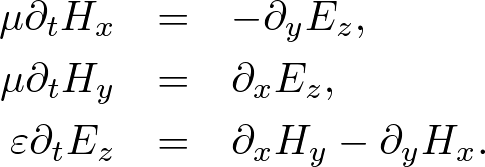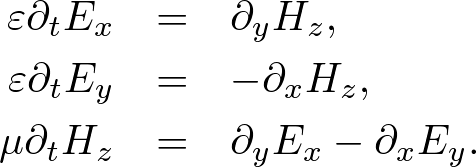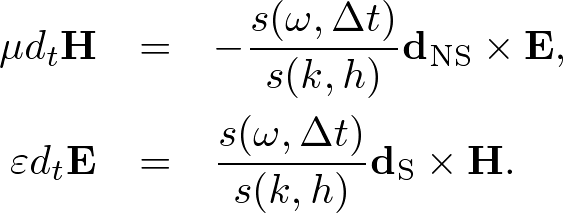Beginner Course
Intermediate Course
Advanced Course2. 2D Maxwell's EquationsThe non-conductive and non-dispersive Maxwell's equations are given by where H = (Hx, Hy, Hz) is the magnetic field, E = (Ex, Ey, Ez) is the electric field, μ is the permeability, and ε is the permittivity. In two-dimensions the Maxwell's equations are separated into two-independent modes: transverse magnetic (TM) and transverse electric (TE) modes. In the TM mode (E parallel to media interfaces), the Maxwell's equations become  . . . (2) . . . (2)Whereas in the TE mode (E perpendicular to media interfaces), the Maxwell's equations become  . . . (3) . . . (3)These Maxwell's equations can be solved by the FDTD algorithm what is called "Yee algorithm." Standard Yee Algorithm Fig. 1. Yee cell in two dimensions. h is the grid spacing. Ex, Ey, Ez are electric field components. Hx, Hy, Hz are magnetic field components. (a) Ez, Hx, Hy alternately lie on the grid in TM mode. (b) Ex, Ey, Hz alternately lie in TE mode. In 1996, K. S. Yee developed a staggered grid what called "Yee cell." The Maxwell's equations are wisely discretized on the Yee cell using the central finite difference model. As shown in Fig. 1, we define the staggered grid,  . . . (4) . . . (4)We can alternately update E and H. Using the S-FDTD algorithm on the Yee cell, the Maxwell's equations are discretized by  . . . (5) . . . (5)where dS = (dx, dy, 0). Expanding the temporal difference operators, we obtain a "2D standard (S) Yee algorithm,"  . . . (6) . . . (6)Nonstandard Yee AlgorithmThe Maxwell's equations are transformed to the wave equation. Applying ∇× to both sides of (1), we obtain In homogeneous media, Gauss' law gives, ∇⋅E = 0. Using a vector identity, we obtain Substituting (7) and (8) into (1), we obtain the wave equation, where v = 1/(με)1/2. In inhomogeneous media, Gauss'law gives, ∇⋅(εE) = E⋅∇ε + ε∇⋅E = 0. In the TM mode, ∇⋅E = 0 because E⊥∇ε. In the TE mode, however, ∇⋅E ≠ 0 and the coupled wave equations are derived, We already have the NS-FDTD algorithm for the homogeneous wave equation. If we find a difference operator, dNS, satisfies dNS2 = dNS⋅dNS, a high-accuracy discretization for the Maxwell's equations is directly transformed from the NS-FDTD algorithm for the wave equation. But such difference operator does not exist because it is impossible to calculate dNS = (dS + γ1dx2dy2)1/2. Instead we require that where Using (12), the Maxwell's equations are discretized by  . . . (13) . . . (13)Applying dS× to both sides of (13), we obtain In homogeneous media, Gauss' law gives Substituting (14) and (15) into (13), we obtain the NS-FDTD algorithm for the homogeneous wave equation, Thus, (13) is a high accuracy form optimized to monochromatic wave propagation. Expanding dtH and dtE, we obtain a "2D nonstandard (NS) Yee algorithm,"  . . . (17) . . . (17)where Z = (μ/ε)1/2 is the wave impedance. This transform is an approximation in the TE mode, nevertheless, the NS-Yee algorithm provides much higher accuracy than the S-Yee one. To reduce the numerical errors, we additionally can modify the form, where
Copyright (C) 2011 Naoki Okada, All Rights Reserved.
|